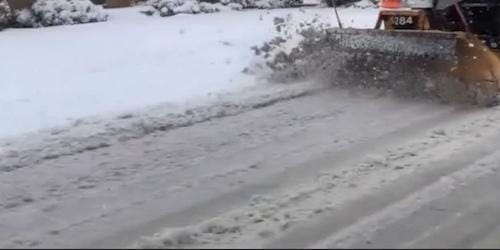Getting ready for Winter 2021! In Michigan the winter can be a brutally cruel season for drivers when the snow, ice, sleet, and slush cover the highways and streets. However, some motorists enjoy the winter weather for skiing, ice skating and boogie board sports. Others use skid steers, plows, and snow blowers to dig out of Mother Nature’s mess.
Our personal injury law firm has experience with snowplow crash accident that result in significant damage and serious injuries or fatalities. In addition to catastrophic injuries, the loss of even one snowplow due to a crash can significantly affect the local economy and how quickly highways and roads are cleared of snow and ice.
Snowplow drivers use heavy trucks to clear the highways and streets of snow while salt trucks trying to make the slippery or icy roads easier to drive on. These two winter snow clearing activities work hand-in-hand to ensure that workers and residents in Michigan can have a better chance of getting to their destinations safely.
In Michigan, we have a shortage of salt truck drivers. The Michigan Department of Transportation (MDOT) has announced that due to the shortage of commercial salt truck drivers, they could be issuing waivers for CDL license. Based on our experience in handling salt truck injury victim accidents, we would prefer that MDOT hire experienced CDL licensed drivers due to their special education and training. Salt truck drivers are especially important for making sure that roads and highways do not become ice rinks. In the winter, you can find yourself driving behind one of these large heavy trucks on your way to work or home. One of the most important tips to avoid collision with a snowplow or salt truck is keep extra distance from these vehicles.
What Can I Do To Avoid Crashing Into Snowplow or Salt Truck?
Defensive driving is key to avoiding a snowplow accident. There tend to be more serious injuries related to salt trucks. Due to the enormous size of snowplows and salt trucks it can be difficult driving behind them, given snow clearing and salting work they are doing.
You need to drop back further behind the plow truck or salt truck and pay attention to the lights or listen closely to the warning beeping sound these heavy machines make.
How To Avoid Street Parking Damage To Your Vehicle?
City of Detroit and Wayne County snowplows and salt trucks can be dangerous, especially if you dangerously park your vehicle on the side of the Streets, where the salt truck driver could sideswipe your vehicle. In some cases, the drivers may park for the night and find their vehicle severely damages or covered with snow. Try not to park in the street before an impending snow fall, or before the snowplow truck and salt truck is coming through your neighborhood.
The options for parking spaces are becoming limited with the accumulating snow, and the ice means that both negligent salt truck drivers and negligent motorists in general could collide with a car safely parked for the night. You will have to examine how close your car is to the curb and street corner in case you want to avoid a terrible accident.
What Does Salt Exposure Do To My Car?
In Michigan, salted roads and highways help drivers keep traction on the roadway, However, salt can cause corrosion on vehicle bodies, mufflers, coil springs and frames. Following directly behind a salt truck can add salt exposure to your vehicle. You should change your location to avoid being hit by salt pellets to minimize the salt damage, but you should also get your vehicle washed soon after your encounter to avoid potential damaging effects to your vehicle.
Salt trucks can appear unexpectedly, but you should always expect in the wintertime that these potential safety hazards are real. Winter conditions are unpredictable and so can road conditions. Unfortunately most crashes occur as result of drivers being unprepared for the change in season.

This photo shows blade of snowplow truck pushing snow on residential street.
What Are The Most Common Types of Snowplow Crashes?
In Michigan between 2012 to 2017 there were approximately 1,300 snow plow related crashes. Research has shown that the following are the most common types of preventable snowplow crashes:
- Striking Fixed-object
- Crashes Running off the road
- Crash Backing up
- Wing-plow strikes
- Snowplow rear-ended by Crashing vehicle
- Driver fatigue
- Driver Distraction
- Driver inattention
- Following too close
Salt truck and snowplow drivers can avoid these types of crashes by using defensive driving techniques such as looking further down the road, scanning by keeping eyes moving, looking behind the vehicle, managing space around the vehicle, and making eye contact with other drivers.
There are driving courses that offer a wide range of defensive driving programs aimed at drivers of commercial motor vehicles, such as motorcoaches, buses, semi trucks, straight trucks, and light and medium duty vehicles.
How To Stay Safe Around a Snowplow or Salt Truck?
A snowplow can weigh up to 80,000 pounds – that’s 25 times more than the average passenger vehicle. So, when cars and plows collide, the occupants of the smaller passenger vehicle sustain the more severe injuries. Staying safe around snowplows or salt trucks is important to keep the following in mind:
- Keep a safe distance away from the snowplow or salt truck, especially the blind spots.
- Behind a snowplow or salt truck, stay between 5 to 10 car lengths away to allow stopping distance and avoid snow blow back.
- Stay to the right away from undivided highway, as snowplow or salt truck approaches you in the opposite direction.
- Reduce speed for weather conditions and always maintain a safe speed. Snowplows and Salt Trucks can travel at a slower speed than other vehicles on the road so be sure to slow down behind them.
- Never pass a snowplow unless it’s safe to do so because the plowed snow can block your vision.
- Limit driving in during fresh winter snow fall if possible. Always turn on your headlights or running lights even during daylight hours so snowplow drivers, salt truck drivers, and other motorists can see you.
- Keep aware of snow removal equipment using flashing yellow lights.
- Keep children away from roads or streets in the winter, as a snowplow or salt truck is being operated because they may not see kids behind or around a pile of snow.
Our personal injury truck accident law firm has handled many tragic snowplow and salt truck injury accidents over the past three decades that were due to preventable human error.
What Are Common Snow Plow Crash Injuries?
An accident involving a snowplow, salt truck or other snow removal vehicle equipment can cause similar types of injuries typically seen after any large heavy truck crash, including:
- Back and Neck Injury
- Traumatic Brain Injury
- Broken Bone
- Concussion
- Facial Injury
- Internal Injury
- Scarring
- Laceration
- Amputation of limb
- Sciatic Nerve Damage
- Head Skull Fractures
- Spinal Cord Injury
- Fatality
Contact An Experienced Snowplow and Salt Truck Lawyer
Our law firm has the experience and skill in representing injury victims due to negligent operation of snowplow and salt truck accidents that can involve more severe injuries. These tragic utility truck accidents can be complex for most lawyers and may have multiple responsible parties than a normal passenger motor vehicle crash, where you are less likely to have all of your damages covered by insurance. Our law firm has the resources and expertise to handle these complex large truck accident cases and won’t hesitate to file a lawsuit on your behalf to get the compensation you deserve.
If you or a family member were hurt in a crash involving a snowplow, salt truck, or other snow removal vehicle, call now toll free at 1-866-447- 3563 or contact us through our website.


